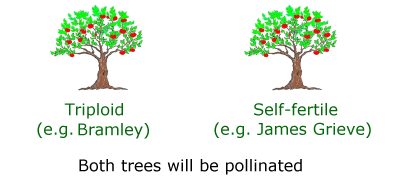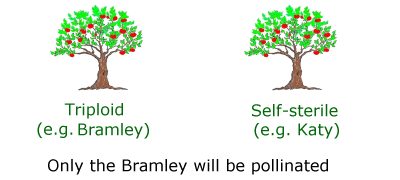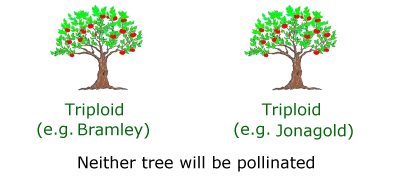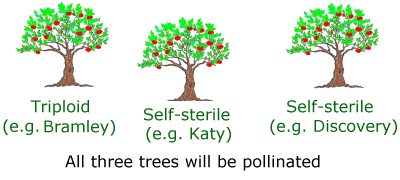So if you have a triploid apple tree, you will need a suitable apple tree nearby to pollinate it. See our pollination group finder here to do that.
You will also need to remember that if the pollination partner is itself self-sterile, as many apple trees are, that apple tree will also need a pollination partner because it cannot be pollinated by the triploid apple tree. If however the pollination partner is self-fertile then it will not need another apple tree to pollinate it because it will not only pollinate the triploid apple tree (if in the correct pollination group) but also itself.
It is a common misconception that triploid apple trees need two suitable pollination partners but this is not true, they only need one. Just in case you are wondering, a triploid apple tree cannot pollinate another triploid apple tree whatever varieties they are. See the following four pictures for a graphical explanation of how triploid apple trees can / cannot be pollinated.
EXAMPLE 1

In example 1 above, both trees will be pollinated as follows:
- James Grieve is partially self-fertile so it can pollinate itself without assistance from other varieties
- James Grieve can pollinate the triploid Bramley because they produce flowers at roughly the same time.
EXAMPLE 2

In example 2 above only the Bramley apple tree will be pollinated because:
- Katy can pollinate the triploid Bramley because they produce flowers at roughly the same time.
- Katy cannot be pollinated by the triploid Bramley
- Katy cannot pollinate itself because it is self-sterile.
EXAMPLE 3

In example 3 above neither apple tree will be pollinated because:
- The Bramley apple tree is a triploid so it cannot pollinate any other apple tree.
- The Jonagold apple tree is a triploid so it cannot pollinate any other apple tree.
EXAMPLE 4

In example 4 above all the apple trees will be pollinated because:
- Katy can pollinate Discovery because they produce flowers at roughly the same time (although it cannot pollinate itself because it is self-sterile).
- Discovery can pollinate Katy because they produce flowers at roughly the same time (although it cannot pollinate itself because it is self-sterile)
- Both Katy and Discovery can pollinate Bramley because all three produce flowers at roughly the same time.
Although triploid apple trees have very specific requirements for pollination it is easy to forget that in most situations, especially in towns, pollination will occur from nearby apple trees without any thought needing to be given to planting other apple trees specifically for pollination purposes. A clear example of this is the Bramley apple tree which is one of the most common in the UK. Without many owners realising it, this variety is a triploid apple tree but normally produces masses of apples year after year without problems.
COMMON VARIETIES OF TRIPLOID APPLE TREES
We list below the most common triploid apple trees and that includes a couple of very popular and worthy varieties illustrating that this type of apple tree is rarely a problem.
For the full list of confirmed triploid apple varieties, click here. The link will download a pdf file onto your computer and you will find the list of triploid apples in Table 7.
ASHMEAD’S KERNEL
An old variety which has a distinctly pear shaped flavour.
BELLE DE BOSKOOP
Pleasant tasting apple which is good for eating and cooking
BLENHEIM ORANGE
Known to date back to at least 1740 this variety is good for eating and cooking with lots of flavour and texture.
BRAMLEY’S SEEDLING
A very strong growing cooking apple tree with good disease resistance and excellent cooking properties.
CLAYGATE PEARMAIN
A strong growing russet, eating apple. Dates back to 1821 and was awarded an RHS AGM in 1993. Good disease resistance and suitable for the Midlands and Northern parts of the UK
CRISPIN (MUTSU)
An acidic eater or an excellent cooker, large apples, strong growing tree.
GRAVENSTEIN
An early variety with lots of aroma and taste. Dates back to at least 1660.
HOLSTEIN
Lots of flavour, juicy, similar to Cox’s Orange Pippin
JONAGOLD
An American variety which has lots of juice and flavour.
JUPITER
A good variety for cooler and wetter than average conditions. Even more aromatic than Cox’s Orange Pippin
NEWTOWN PIPPIN
Awarded an AGM in 1962, one of the parents to Cox’s Orange Pippin though slightly more acidic.
ORLEANS REINETTE
Very full flavoured, excellent disease resistance, good choice for wet areas.
RIBSTON PIPPIN
Awarded an AGM in 1962, one of the parents to Cox’s Orange Pippin though slightly more acidic.
ROXBURY RUSSET
USA variety dating back to 1600, good disease resistance.
SUNTAN
Attractive looking apple, acidic flavour. Low resistance to canker and bitter pit.
Rootstocks and Size
Guide to Planting
Care Plan
Pruning Apple Trees
Harvest and Storage
Pests and Disease
Pollination Groups
TRIPLOID APPLE TREES
By David Marks
A “triploid” apple tree is one which has three chromosomes rather than the normal two and they should be treated as if they are self-sterile. This means that they need another suitable variety nearby to pollinate them.
Another feature of triploid apple trees is that not only are they self-sterile (i.e. they cannot pollinate themselves) but they cannot pollinate other apple trees. With those complications lining up against triploid apple trees it may at first glance appear that they are best ignored but in fact they tend to be very vigorous trees and often have good disease resistance.